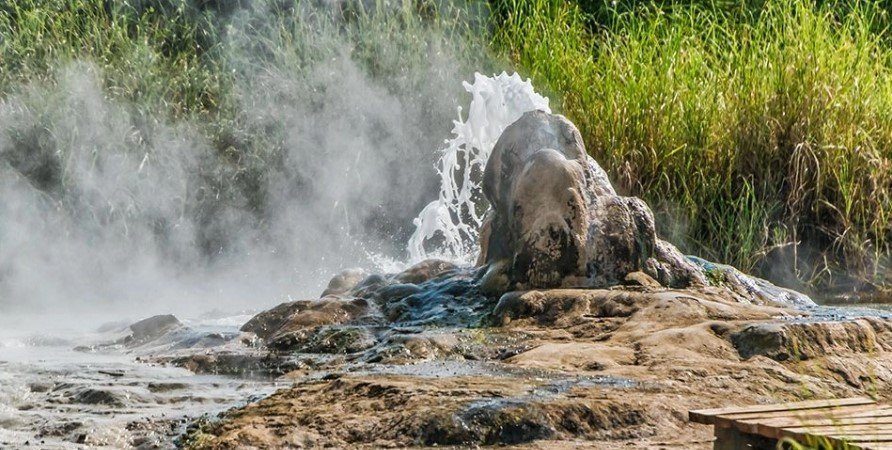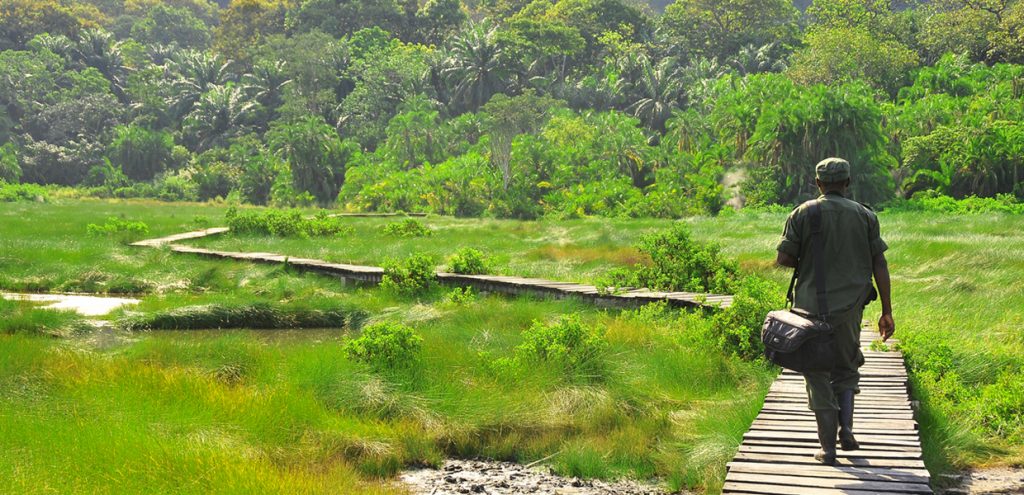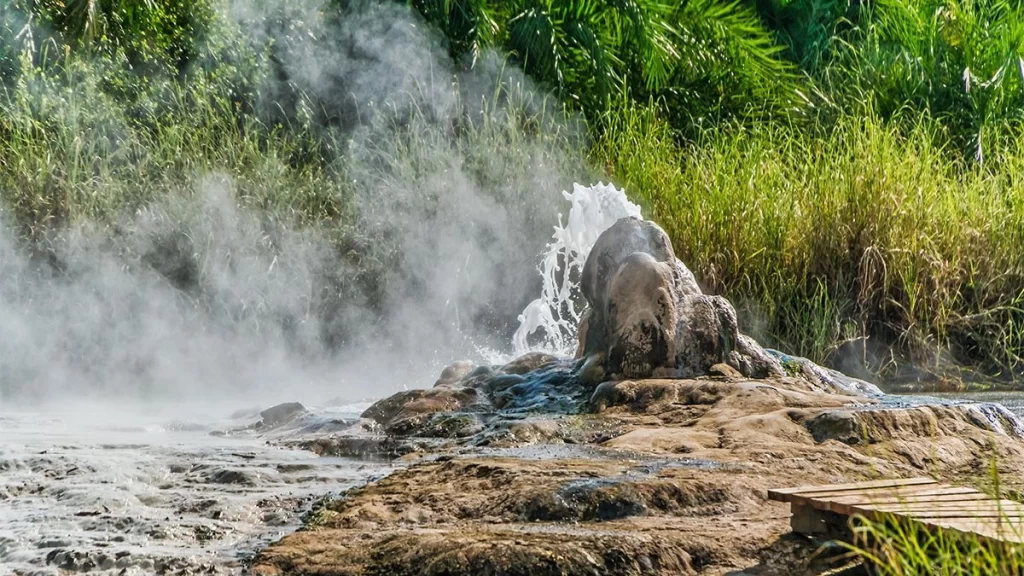Semuliki National Park in Uganda
Semuliki National Park is located in western Uganda, within the Bundibugyo district, and to the border with the Democratic Republic of Congo. The park is flanked by Lake Albert to the north and the Rwenzori Mountains to the southeast. Two rivers, Lamia and Semuliki, are located at the borders of the park. Semuliki National Park is situated on relatively level terrain, rendering it susceptible to flooding when the park’s rivers get excessive rainfall during the rainy season.
Semuliki National Park, Uganda Semuliki originated as a forest reserve in 1932 and was designated a national park in 1993 primarily to mitigate deforestation. Semuliki National Park is frequently mistaken for the adjacent Semliki Wildlife Reserve. The Semuliki woodlands are an extension of the enormous Ituri Forest, which extends to the Zaire River. This extension indicates that numerous tree and animal species native to Central Africa are present in the park. The circumstances in Semuliki markedly differ from those in any other national park in Uganda, Kenya, or Tanzania, yet they resemble those found in central Africa.

Semuliki is renowned as a premier birdwatching locale in Uganda. The park hosts more than 410 avian species. Approximately 67 percent of the species are forest-dwelling birds, including the Blue-headed Crested Flycatcher, Capuchin Babbler, Dwarf Honeyguide, Forest Ground Thrush, Orange Weaver, Purple-breasted Sunbird, Sassi’s Olive Greenbul, and White-tailed Hornbill. The park has species endemic to central Africa, such as the Black-wattled Hornbill, Congo Serpent Eagle, Long-tailed Hawk, Lyre-tailed Honeyguide, and Nkulengu Rail, due to its connection with the forest of the Democratic Republic of Congo.
Semuliki National Park, Uganda The park is home to 60 mammalian species, including the bay duiker, Beecroft’s anomalure, flying squirrels, bush babies, bush pigs, civets, dwarf antelope, elephants, fruit bats, fire-footed rope squirrels, forest buffaloes, pygmy hippos, leopards, little collared fruit bats, mona monkeys, pygmy flying squirrels, red-legged sun squirrels, sitatungas, target rats, water chevrotains, waterbucks, warthogs, Uganda kob, white-bellied duiker, and Zenker’s flying mouse. The park’s woodlands host over 300 butterfly species, including charaxes and forest swallowtails, as well as 8 primate species, such as blue monkeys, chimpanzees, De Brazza’s monkeys, Guereza colobus, vervet monkeys, and olive baboons. Night primates include species such as pottos and galagos.
The woodlands and wildlife of Semuliki National Park are endangered due to encroachment by nearby human populations. The wildlife in the park continues to be killed for their flesh, while the trees supply herbs, vegetables, and firewood. Two primary tribes inhabit the area surrounding the park: the Bamba and Bakonjo.

The Bamba cultivate crops in the base of the Rwenzori Mountains, whereas the Bakonjo farm the mountain slopes. Pastoralists such as the Batuku and Batwa hunters on the periphery of the forest within the park. Approximately 120 Basua continue to exist as hunters and gatherers within the jungle. The Basua are pygmies akin to the Batwa, having resided in the forests for millennia. However, their recent expulsion from sections of the forest and inability to acclimate to life beyond it have raised worries on the effects of unplanned eviction on specific indigenous communities. The Basua people confront imminent extinction and the obliteration of their culture and history due to their displacement from the forest, akin to the protection afforded to certain forests and species.
Activities in Semuliki National Park
Butterfly at Semuliki National ParkThe park offers an abundance of activities. Tourists interested in Semuliki may engage in forest hikes, birdwatching, primate observation, visiting the two hot springs, trekking, and wildlife drives. A cultural excursion to a native tribe residing outside the park is essential for a comprehensive safari experience in Semuliki National Park.
The Sempaya Hot Springs
The two thermal springs have rendered the park very renowned. Tourists are more captivated by the local narratives regarding their formation than by the scientific elucidation. There are separate hot springs for females and males. The male hot spring, known as Bintente, has a diameter of around 12 meters, while the female hot spring is referred to as Nyasimbi. A boiling geyser erupts vapor and bubbling water many meters high, visible from almost 1 kilometer away. Geothermal Springs in Semuliki National ParkThe water erupting is enough hot to boil eggs within 10 minutes. Historically, the forest inhabitants utilized the hot springs for cooking; however, park management has restricted this practice to accommodate tourism. As visitors approach the hot springs, they observe many bird species and little primates ascending and descending the trees. The park authorities constructed a tower and boardwalk for the safe observation of the hot springs. Indigenous groups typically arrange cultural dances to amuse visitors attracted by the hot springs. In addition to the hot springs, avifauna, and primates, tourists may also explore the Mungiro Falls or embark on a neighboring forest hike.

The Semuliki River spans around 160 kilometers in length. This turbid forest river is one of the water sources that feeds the big river Nile. The river hosts crocodiles, hippos, and several avian species. Visitors enjoy lengthy strolls along the river as it winds through woods and rift valley flora.
Forest & Nature Walks
A favored activity in the park involves traversing the forested areas to observe the flora, avifauna, lepidopterans, and primates. Forest walks often commence at the Sempaya park entrance and conclude near the hot springs. The park features three designated walking pathways. The Sempaya Nature Trail spans 8 kilometers, the Red-Monkey Track measures approximately 11 kilometers, and the Kirumia Hiking Trail extends 13 kilometers. Hikers must carry essential tools, such as a machete, to clear overgrown foliage when navigating forest routes. Individuals wishing to camp in the forest must bring their own equipment.
A visit to Semuliki National Park Game drives in Semuliki National Park provide opportunity to observe more than 52 previously mentioned mammal species. The park features three primary routes designated for game drives that traverse the savannah plains. Staff in the park organize both diurnal and nocturnal game drives. Visitors must own a robust four-wheel-drive vehicle to navigate the more challenging areas of the park, especially during the rainy season.
Chimpanzee tracking
Chimpanzee tracking: Indiana University has habituated several tribes of chimpanzees that are now accessible for tourism. The cost of chimpanzee monitoring permits for international visitors is $30. During chimpanzee tracking, tourists should anticipate encountering smaller primates such as the Black and White Colobus monkeys, Central African Red Colobus, Dent’s Mona monkeys, Grey-cheeked Mangabey, Olive Baboons, and Red-tailed monkeys, among others. It is essential to arrive equipped with appropriate attire and gear to safeguard against stinging insects, sharp branches, and thorns. Bring sufficient drinking water and a little lunch.
The vicinity of the National Park is inhabited by four indigenous tribes, offering cultural trips and experiences. Visitors may select to explore any of the four tribes residing around the periphery of the park. The Batwa pygmies engage in hunting and foraging, whilst the Bakonjo and Bamba cultivate crops like as rice, matooke (bananas), potatoes, and cocoa on the slopes of Mount Rwenzori. The Batuku inhabit the northern region of the park as pastoralists. Tourism and industrialization are transforming the life of these tribes, especially the Batwa. The Batwa formerly inhabited the forests of Rwanda, Uganda, and the Democratic Republic of Congo but have since been resettled to regions beyond the national parks. A portion of the Batwa in Semuliki National Park has been relocated to an area near Ntandi with assistance from the Christian charity ADRA; nevertheless, this endeavor has yielded limited results, as they continue to yearn for their former lifestyle in the forest. Certain members of the Batwa, with assistance from the Uganda Wildlife Authority, exhibit their cultural history to visitors via dance, storytelling, and various performances. The Batwa cultivate and cure cannabis.

Birdwatching
Semuliki National Park is among the premier locations for avian observation in Uganda. Semuliki National Park harbors fifty percent of the avian species present in the Democratic Republic of Congo, as it is an extension of the expansive Ituri Forest, which extends to the Zaire River. This extension facilitates the migration of species from Central Africa to Semuliki National Park. Birdwatching at the park can occur in the forest, near the Sempaya hot springs, or behind the ranger’s station. Avifauna Observation in Semuliki National ParkIn addition to the previously enumerated species, others encompass the African Dwarf Kingfishers, African Piculet, Bates’ Nightjar, Black Dwarf Hornbill, Black-collared Lovebird, Black-wattled Hornbills, African Goshawk, Ayres Hawk-Eagle, Cassin’s Spinetail, Great Sparrows, Red-thighed Sparrows, White-spotted Flufftail, Black-winged Starling, and Brown-crowned Eremomela. Chestnut-breasted Negro Finches, Chestnut-flanked Goshawk, Chocolate-backed Malimbes, Crested Malimbes, Eastern Bearded Greenbuls, Forest Francolin, Forest Thrushes, Gabon Woodpecker, Grant’s Bluebill, Green-tailed Bristlebill, Grey Ground Thrushes, Hartlaub’s Duck, Ituri Batis, Lemon-bellied Crombec, Maxwell’s Black Weaver, Northern Bearded Scrub Robin, Pale-fronted Finches, Piping Hornbills, Red-bellied Malimbes, Red-billed Dwarf, Red-billed Helmet Shrike, Red-chested Owlet, Red-eyed Puffback, Red-rumped Tinkerbird, Red-sided Broadbill, Red-thighed Sparrowhawk, Simple Greenbuls, Spot-breasted Ibis, Spotted Lyre-tailed Honeyguides, Western Bronze-naped Pigeon, White-bellied Kingfisher, White-throated Blue Swallow, Yellow-throated Cuckoo, Yellow-throated Nicator, and Zenker’s Honeyguides. In the late evening, the nocturnal inhabitants such as the African Wood Owl and the Buff-spotted Flufftail become audible.
Best time for a visit to Semuliki National Park
Semuliki National Park is open year-round. The optimal months for visitation are during the dry seasons of April to June and July to September. During these arid months, traversing the park is facilitated by reduced mud accumulation. The wet season, occurring from December to March and from October to November, complicates navigation across the area. Certain areas of the park become inundated when the precipitation saturates the rivers.
Accessing Semuliki National Park
The distance from Kampala to Fort Portal by road is 300 kilometers. Two routes exist from Kampala to the park. One may utilize the quicker route from Kampala to Fort Portal via Mubende, which requires approximately four to five hours, or opt for the lengthier path through the towns of Kasese, Mbarara, and Masaka. This extended journey (7 to 8 hours of driving) provides opportunity to view several of Uganda’s renowned national parks, including Queen Elizabeth, Rwenzori Mountains, and Lake Mburo. Upon arriving in Fort Portal town, it is approximately 52 kilometers to the intersection directing to the park from the main route. A robust four-wheel drive is essential for traversing the park roads, particularly during the rainy season.
Individuals utilizing public transportation must acquire a taxi from Fort Portal town to Bundibugyo and disembark at the Sempaya entrance of the park. The Park headquarters at Ntandi are located 5 kilometers from the Sempaya entrance. Public transportation to Bundibugyo is unreliable, and one may experience prolonged waiting periods for taxis and minibuses, particularly in the evening.
